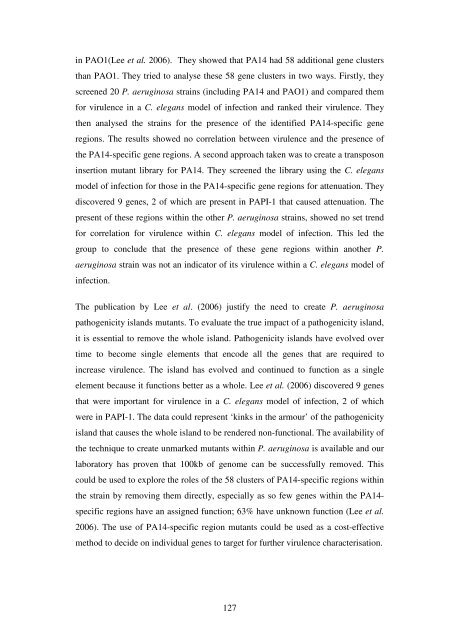5 The role of quorum-sensing in the virulence of Pseudomonas ...
5 The role of quorum-sensing in the virulence of Pseudomonas ...
5 The role of quorum-sensing in the virulence of Pseudomonas ...
Create successful ePaper yourself
Turn your PDF publications into a flip-book with our unique Google optimized e-Paper software.
<strong>in</strong> PAO1(Lee et al. 2006). <strong>The</strong>y showed that PA14 had 58 additional gene clusters<br />
than PAO1. <strong>The</strong>y tried to analyse <strong>the</strong>se 58 gene clusters <strong>in</strong> two ways. Firstly, <strong>the</strong>y<br />
screened 20 P. aerug<strong>in</strong>osa stra<strong>in</strong>s (<strong>in</strong>clud<strong>in</strong>g PA14 and PAO1) and compared <strong>the</strong>m<br />
for <strong>virulence</strong> <strong>in</strong> a C. elegans model <strong>of</strong> <strong>in</strong>fection and ranked <strong>the</strong>ir <strong>virulence</strong>. <strong>The</strong>y<br />
<strong>the</strong>n analysed <strong>the</strong> stra<strong>in</strong>s for <strong>the</strong> presence <strong>of</strong> <strong>the</strong> identified PA14-specific gene<br />
regions. <strong>The</strong> results showed no correlation between <strong>virulence</strong> and <strong>the</strong> presence <strong>of</strong><br />
<strong>the</strong> PA14-specific gene regions. A second approach taken was to create a transposon<br />
<strong>in</strong>sertion mutant library for PA14. <strong>The</strong>y screened <strong>the</strong> library us<strong>in</strong>g <strong>the</strong> C. elegans<br />
model <strong>of</strong> <strong>in</strong>fection for those <strong>in</strong> <strong>the</strong> PA14-specific gene regions for attenuation. <strong>The</strong>y<br />
discovered 9 genes, 2 <strong>of</strong> which are present <strong>in</strong> PAPI-1 that caused attenuation. <strong>The</strong><br />
present <strong>of</strong> <strong>the</strong>se regions with<strong>in</strong> <strong>the</strong> o<strong>the</strong>r P. aerug<strong>in</strong>osa stra<strong>in</strong>s, showed no set trend<br />
for correlation for <strong>virulence</strong> with<strong>in</strong> C. elegans model <strong>of</strong> <strong>in</strong>fection. This led <strong>the</strong><br />
group to conclude that <strong>the</strong> presence <strong>of</strong> <strong>the</strong>se gene regions with<strong>in</strong> ano<strong>the</strong>r P.<br />
aerug<strong>in</strong>osa stra<strong>in</strong> was not an <strong>in</strong>dicator <strong>of</strong> its <strong>virulence</strong> with<strong>in</strong> a C. elegans model <strong>of</strong><br />
<strong>in</strong>fection.<br />
<strong>The</strong> publication by Lee et al. (2006) justify <strong>the</strong> need to create P. aerug<strong>in</strong>osa<br />
pathogenicity islands mutants. To evaluate <strong>the</strong> true impact <strong>of</strong> a pathogenicity island,<br />
it is essential to remove <strong>the</strong> whole island. Pathogenicity islands have evolved over<br />
time to become s<strong>in</strong>gle elements that encode all <strong>the</strong> genes that are required to<br />
<strong>in</strong>crease <strong>virulence</strong>. <strong>The</strong> island has evolved and cont<strong>in</strong>ued to function as a s<strong>in</strong>gle<br />
element because it functions better as a whole. Lee et al. (2006) discovered 9 genes<br />
that were important for <strong>virulence</strong> <strong>in</strong> a C. elegans model <strong>of</strong> <strong>in</strong>fection, 2 <strong>of</strong> which<br />
were <strong>in</strong> PAPI-1. <strong>The</strong> data could represent ‘k<strong>in</strong>ks <strong>in</strong> <strong>the</strong> armour’ <strong>of</strong> <strong>the</strong> pathogenicity<br />
island that causes <strong>the</strong> whole island to be rendered non-functional. <strong>The</strong> availability <strong>of</strong><br />
<strong>the</strong> technique to create unmarked mutants with<strong>in</strong> P. aerug<strong>in</strong>osa is available and our<br />
laboratory has proven that 100kb <strong>of</strong> genome can be successfully removed. This<br />
could be used to explore <strong>the</strong> <strong>role</strong>s <strong>of</strong> <strong>the</strong> 58 clusters <strong>of</strong> PA14-specific regions with<strong>in</strong><br />
<strong>the</strong> stra<strong>in</strong> by remov<strong>in</strong>g <strong>the</strong>m directly, especially as so few genes with<strong>in</strong> <strong>the</strong> PA14-<br />
specific regions have an assigned function; 63% have unknown function (Lee et al.<br />
2006). <strong>The</strong> use <strong>of</strong> PA14-specific region mutants could be used as a cost-effective<br />
method to decide on <strong>in</strong>dividual genes to target for fur<strong>the</strong>r <strong>virulence</strong> characterisation.<br />
127














